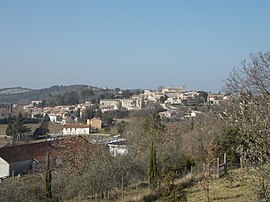Commune in Occitania, France
| Ners | |
|---|---|
| Commune | |
 A general view of Ners A general view of Ners | |
 Coat of arms Coat of arms | |
| Location of Ners | |
  | |
| Coordinates: 44°01′38″N 4°09′34″E / 44.0272°N 4.1594°E / 44.0272; 4.1594 | |
| Country | France |
| Region | Occitania |
| Department | Gard |
| Arrondissement | Alès |
| Canton | Quissac |
| Intercommunality | Alès Agglomération |
| Government | |
| • Mayor (2020–2026) | Patrice Pupet |
| Area | 4.96 km (1.92 sq mi) |
| Population | 751 |
| • Density | 150/km (390/sq mi) |
| Time zone | UTC+01:00 (CET) |
| • Summer (DST) | UTC+02:00 (CEST) |
| INSEE/Postal code | 30188 /30360 |
| Elevation | 79–181 m (259–594 ft) (avg. 123 m or 404 ft) |
| French Land Register data, which excludes lakes, ponds, glaciers > 1 km (0.386 sq mi or 247 acres) and river estuaries. | |
Ners is a commune in the Gard department in southern France.
History
Ners is part of a territory inhabited long before the Roman presence in the region.
The village is located along the ancient road 'voie Régordane' going from Saint-Gilles to Puy-en-Velay. Along this road traders, pilgrims, crusaders and knights crossed the river Gardon.
In 1211 Ners is first time reported as a place of residence with the "castrum nercium" - a watchtower of the twelfth century. This tower was probably constructed as an outpost to the village of Vezenobres as well as to protect the few inhabitants of the village. The tower was gradually expanded and in 1480 it retained its castle walls and is to be considered the oldest building in the village.
Etymology
Etymologically the name can be derived from "Nertius", a Gallo-Roman person with great prestige in ancient times. A manuscript from 1247 mentions the name "Nercium" and in 1547 "Ners".
Population
| Year | Pop. | ±% p.a. |
|---|---|---|
| 1968 | 357 | — |
| 1975 | 362 | +0.20% |
| 1982 | 473 | +3.89% |
| 1990 | 544 | +1.76% |
| 1999 | 618 | +1.43% |
| 2009 | 681 | +0.98% |
| 2014 | 740 | +1.68% |
| 2020 | 712 | −0.64% |
| Source: INSEE | ||
See also
References
- "Répertoire national des élus: les maires". data.gouv.fr, Plateforme ouverte des données publiques françaises (in French). 2 December 2020.
- "Populations légales 2021" (in French). The National Institute of Statistics and Economic Studies. 28 December 2023.
- Population en historique depuis 1968, INSEE
This Gard geographical article is a stub. You can help Misplaced Pages by expanding it. |